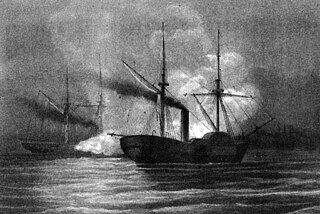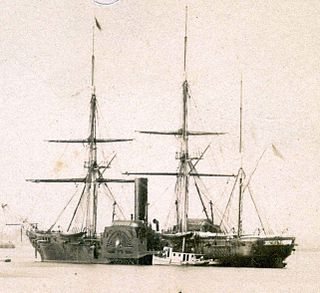
USS Brooklyn (1858) was a sloop-of-war authorized by the U.S. Congress and commissioned in 1859. Brooklyn was active in Caribbean operations until the start of the American Civil War at which time she became an active participant in the Union blockade of the Confederate States of America.

The very first USS Hatteras was a 1,126-ton iron-hulled steamer purchased by the Union Navy at the beginning of the American Civil War. She was outfitted as a gunboat and assigned to the Union blockade of the ports and waterways of the Confederate States of America. During an engagement with the disguised Confederate commerce raider, CSS Alabama, she was taken by surprise and was sunk off the coast of Galveston, Texas. The wreck site is one of the few listed on the National Register of Historic Places because of its location away from destructive surf and because of the ship's side-wheel design, which marks the transition between wooden sailing ships and steam-powered ships.

USS Minnesota was a wooden steam frigate in the United States Navy. Launched in 1855 and commissioned eighteen months later, the ship served in east Asia for two years before being decommissioned. She was recommissioned at the outbreak of the American Civil War and returned to service as the flagship of the North Atlantic Blockading Squadron.
The first USS Arizona was an iron-hulled, side-wheel merchant steamship. Seized by the Confederate States of America in 1862 during the American Civil War, she was captured later the same year by the United States Navy.

The first USS Sabine was a sailing frigate built by the United States Navy in 1855. The ship was among the first ships to see action in the American Civil War. In 1862, a large portion of the USS Monitor crew were volunteers from the Sabine.
USS New London (1859) was a screw steamer of the Union Navy during the American Civil War. She was outfitted with a Parrott rifle and 32-pounders, and was assigned as a gunboat in the Union blockade of the Confederate States of America.

USS Susquehanna, a sidewheel steam frigate, was the first ship of the United States Navy to be named for the Susquehanna River, which rises in Lake Otsego in central New York and flows across Pennsylvania and the northeast corner of Maryland emptying into the Chesapeake Bay.

USS Sciota was a Unadilla-class gunboat built on behalf of the United States Navy for service during the Civil War. She was outfitted as a gunboat, with both a 20-pounder rifle for horizontal firing, and two howitzers for shore bombardment, and assigned to the Union blockade of the waterways of the Confederate States of America.

The first USS San Jacinto was an early screw frigate in the United States Navy during the mid-19th century. She was named for the San Jacinto River, site of the Battle of San Jacinto during the Texas Revolution. She is perhaps best known for her role in the Trent Affair of 1861.

The first USS Seminole was a steam sloop-of-war in the United States Navy during the American Civil War.
The second Navy vessel to bear the name Sachem, this screw steamer was built in 1844 at New York City, where it was purchased by the Navy on 20 September 1861.
The first USS Onward was a clipper in the Union Navy.
USS Rachel Seaman was a wooden schooner purchased by the Union Navy during the American Civil War.

USS Clifton was a shallow-draft side-wheel paddle steamer, built in 1861 at Brooklyn, as a civilian ferry. The Union Navy bought her early that December, and commissioned her after having her converted into a gunboat. In 1863 she ran aground, was captured and commissioned into the Texas Marine Department. Her career ended in 1864 when she ran aground and her Confederate crew burned her to prevent her recapture.
Cottonclads were a classification of steam-powered warships where a wooden ship was protected from enemy fire by bales of cotton lining its sides. Cottonclads were prevalent during the American Civil War, particularly in the Confederate States Navy for riverine and coastal service such as in the battles of Memphis, Galveston, and Sabine Pass. Confederate tactics generally had cottonclads, which were outgunned by Union warships, steam at full speed towards enemy vessels, relying on the cotton to absorb fire. Once they were within firing range, they would open fire, and, if possible, ram or board the enemy.
USS Velocity (1862) was a captured British schooner acquired by the Union Navy from the prize court during the American Civil War.

USS Morning Light (1853) was a sailing ship acquired by the Union Navy during the American Civil War. She was used by the Navy to patrol navigable waterways of the Confederacy to prevent the South from trading with other countries.

USS Calhoun was a captured Confederate steamer and blockade runner acquired by the Union Navy from the prize court during the American Civil War.

John Cummings Howell was an officer in the United States Navy during the American Civil War. He rose to the rank of rear admiral and late in his career was commander-in-chief of the North Atlantic Squadron and then of the European Squadron.

William Edgar Le Roy was an officer in the United States Navy who served in the Mexican War, on the African Slave Trade Patrol, and in the American Civil War. He rose to the rank of rear admiral and late in his career was consecutively commander-in-chief of the South Atlantic Squadron, the North Atlantic Squadron, and the European Squadron.













